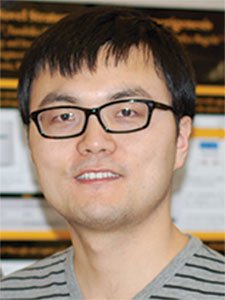Engineering student is at the forefront of discovery

What if we could use a simple “dipstick” test—similar to the tests used to diagnose strep throat or determine pregnancy—to detect deadly diseases like malaria, HIV and tuberculosis in their early stages when treatment is most effective, possibly saving millions of lives?
University of Minnesota mechanical engineering Ph.D. student Zhenpeng Qin has integrated theories, methodologies and technologies from multiple disciplines in his pursuit of answers to this tantalizing question. His work is the result of a prestigious Interdisciplinary Doctoral Fellowship in 2012-13 that allowed him to devote the year to his dissertation research while hosted by one of the University’s research centers.
The challenges—and rewards—of interdisciplinary work
Qin’s research required him to venture into the field of microbiology and infectious diseases in order to develop a new method, thermal contrast, to improve the sensitivity of lateral flow immunoassays.
“Lateral flow assays are common point-of-care rapid tests, like the over-the-counter pregnancy ‘dipstick’ test,” Qin explained.
Such tests work well in late stages of full-blown disease, but just as with a pregnancy test, these tests are not reliable in the very early stages of a pregnancy or an infectious disease. Millions of illnesses and deaths could be avoided worldwide by improving point-of-care diagnosis of infectious diseases where early diagnosis is important to improve outcomes.
The solution? Taking an already available test that uses gold nanoparticles but is unable to produce a visible result for early disease states, and using a laser to generate measurable heat from these gold nanoparticles, increases the sensitivity of the test, thereby allowing much earlier diagnosis.
For Qin, finding good collaborators in other disciplines is both critical and challenging for the success of his interdisciplinary project. Working with multiple collaborators here at the University, at the Tuberculosis Clinical Diagnostics Research Consortium (an international, interdisciplinary consortium of scientists, clinicians, and support personnel), and at Makerere University in Uganda and the University of Cape Town in South Africa, Qin learned the skills of collaboration and coordination required for successful, cross- disciplinary work involving many individuals.
“New ideas and innovations come from interdisciplinary interactions,” Qin said. “The University of Minnesota is a unique environment where collaborations across disciplines can tackle important global problems.”
Centers and mentors play essential roles
The University’s Interdisciplinary Doctoral Fellowship requires the student to spend the fellowship year in residence at a host research center under the mentorship of a faculty member who is affiliated with the center and who is someone other than the student's formal advisor. Each of these talented Ph.D. students found their host center to be a fertile incubator for their ideas, providing them with networking opportunities and connections to other resources they otherwise would not have had.
Qin is convinced that without the Center for Infectious Diseases and Microbiology Translational Research (CIDMTR), his research would not have progressed to where it is today. CIDMTR is a “great match,” since the research he is conducting with his advisor, mechanical engineering professor John Bischof, and his mentor, Professor David Boulware, and others will lead to a platform technology that can be used with a wide range of infectious diseases—and CIDMTR focuses broadly on infectious diseases and has worldwide collaborations.
Especially helpful during his fellowship year was the mentorship provided with respect to both engineering and clinical aspects of his research, and a travel award to present an abstract at the annual conference of the American Society of Tropical Medicine and Hygiene, where Qin was introduced to other investigators interested in point-of-care diagnosis of tropical infectious diseases.
“I feel that I can find someone on campus working on just about anything you can imagine,” Qin said regarding opportunities for collaboration at the University.
A complete list of the 2012-13 Interdisciplinary Doctoral Fellows, with information about their mentors, advisers, areas of focus and host research centers, is available online.
Excerpted from the University of Minnesota Graduate School website.
